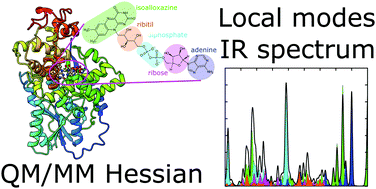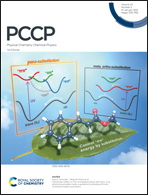Infrared spectroscopy from electrostatic embedding QM/MM: local normal mode analysis of infrared spectra of arabidopsis thaliana plant cryptochrome†
Abstract
Infrared (IR) spectroscopy is an undoubtedly valuable tool for analyzing vibrations, conformational changes, and chemical reactions of biological macromolecules. Currently, there is a lack of theoretical methods to create a model successfully and efficiently simulate and interpret the origin of the spectral signatures, which are often complex to analyze. Here, we develop a new method for IR vibrational spectroscopy based on analytic second derivatives of electrostatic embedding QM/MM energy, the computation of electric dipole moments with respect to nuclear perturbations and the localization of normal modes. In addition to the IR spectrum, the method can provide the origin of each peak from clearly identified molecular motions of constituent fragments. As a proof of concept, we analyze the IR spectra of flavin adenine dinucleotides in water and in Arabidopsis thaliana cryptochrome proteins for four redox forms, in addition to the difference IR spectra before and after illumination with blue light. We show that the main peaks in the difference spectrum are due to N–H hydrogen out-of-plane motions and hydrogen bendings.



 Please wait while we load your content...
Please wait while we load your content...